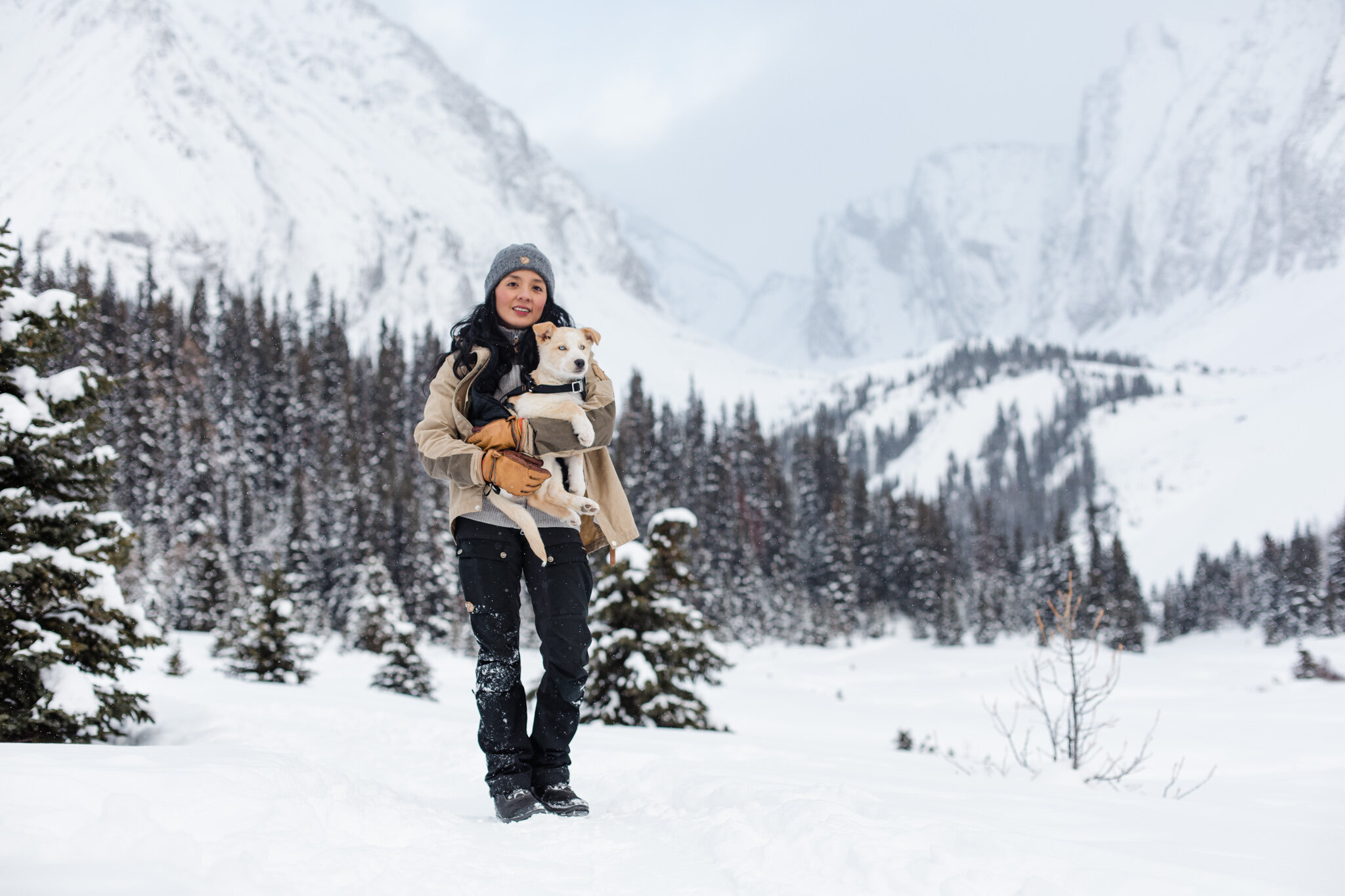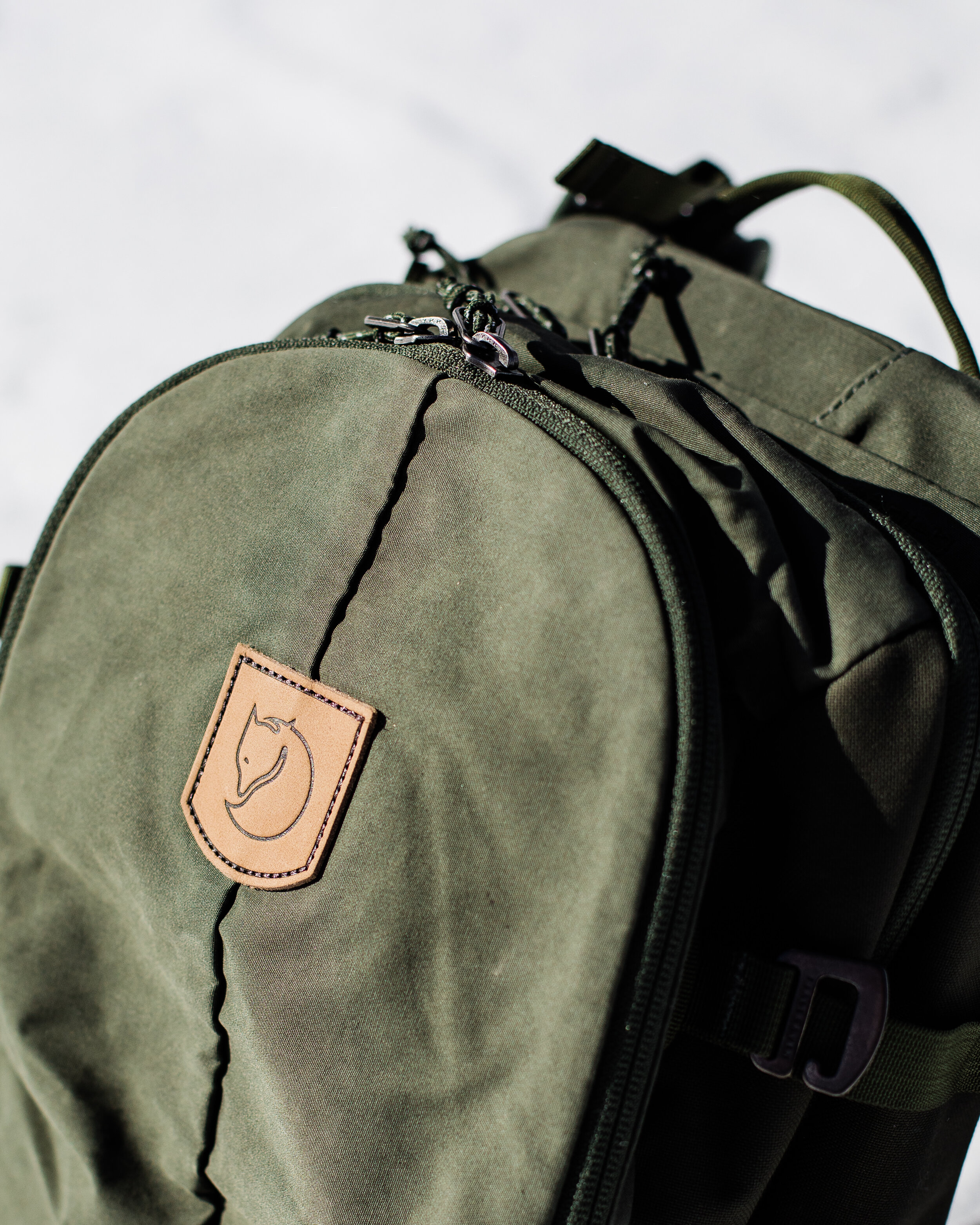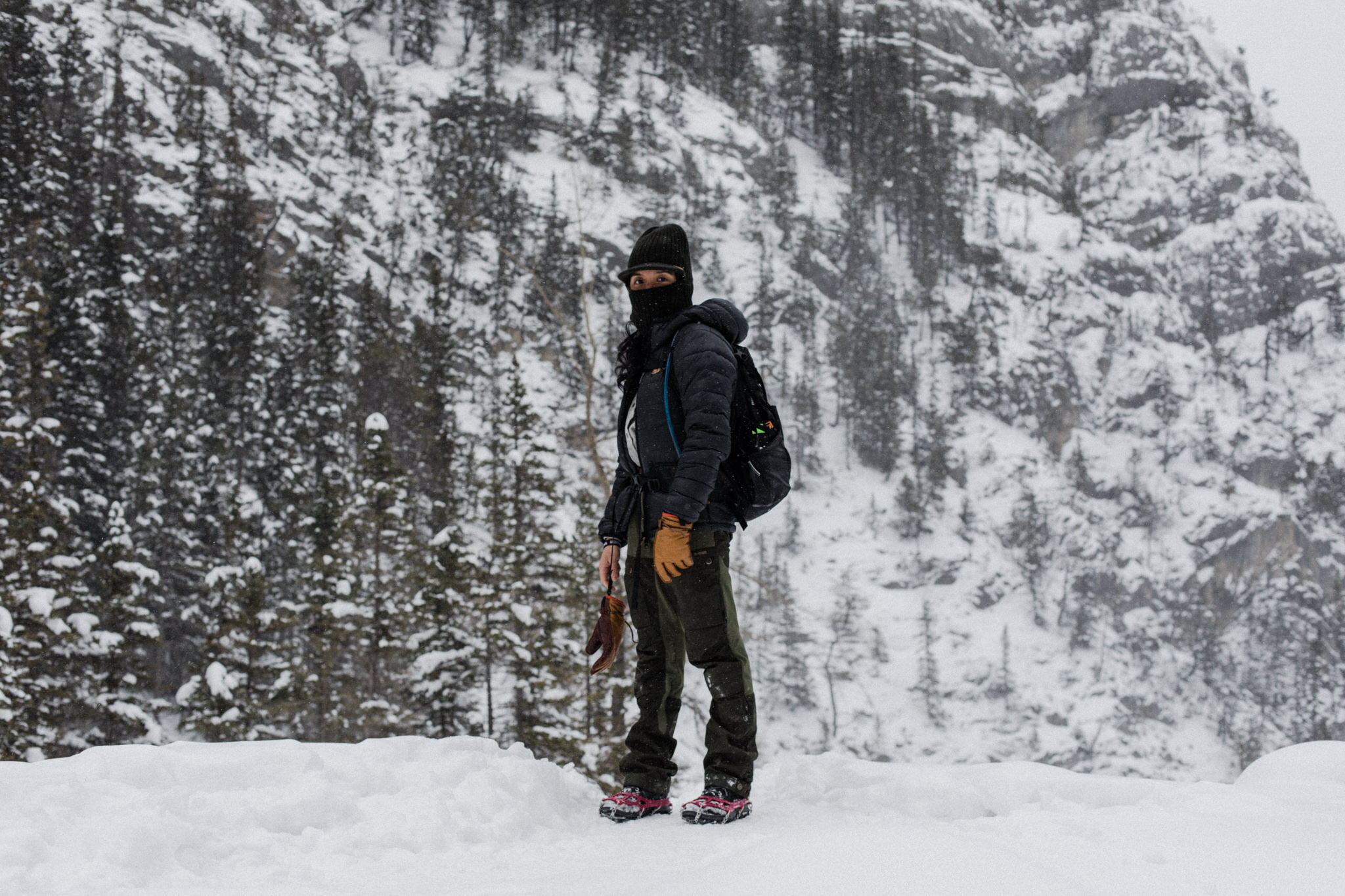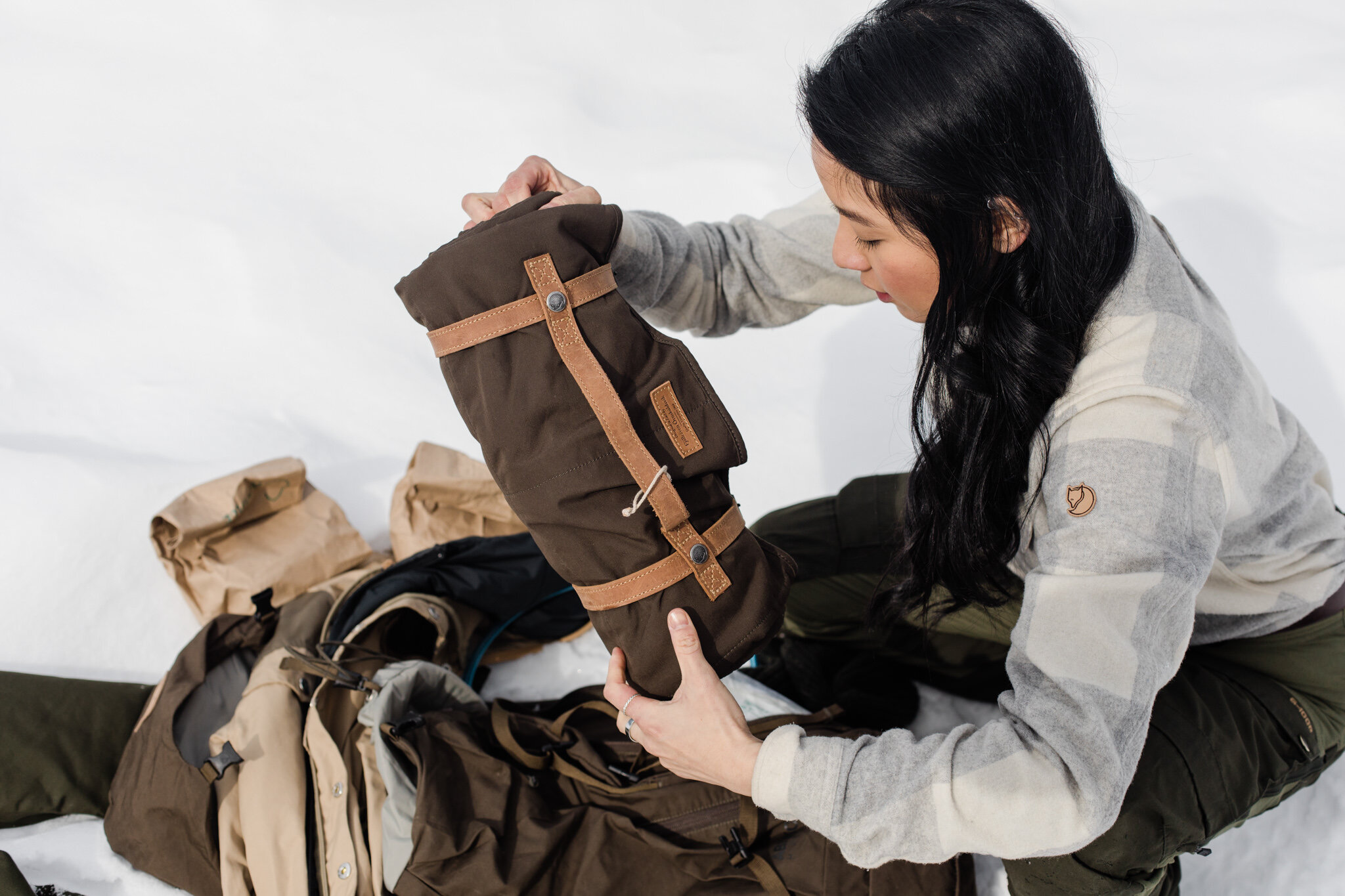A sustainable gear guide for winter hiking and cross-country skiing in Banff.
After living in the Canadian Rockies for four years and counting, I have collected numerous outdoor experiences that I will cherish for life. From summiting mountains at sunrise (which comes with a 3:00am wakeup call), to hiking 90km+ with a backpack one-third of my body weight, to cross-country skiing in -26ºC—there is no shortage of ways to have fun in the mountains, even in the winter.
Learning to enjoy our long, cold winters has a lot to do with being prepared, staying informed, and what gear you take with you. Since moving here, I have learnt that there’s “no such thing as bad weather; only bad clothing”. I don’t usually write about outdoor gear on this space, but I do blog about our hikes often—so why not include a guide to some of our gear?
I’m not in any way an expert, but I have spent many hours doing my own research, trying gear on and really putting it to the test in the Rockies. I am also passionate about sustainability, and try to make the most environmentally-friendly choices I can to the best of my knowledge. I’m sharing what has worked for me to help you make a thoughtful, discerning choice about where you invest your dollars when it comes to outdoor gear. I recommend doing your own research and finding what works for you—try things on and don’t be afraid to walk away if you don’t absolutely love it.
A note on affordability & accessibility
Let me be clear: outdoor gear is not cheap (nor should it be). It is an investment that should also be made based on what you can reasonably afford. You may not be able to get all the right gear all at once, and that’s okay. I’m a big believer in buying once, buying well, and never buying it again—good gear should be something that lasts so long you can pass onto your kids (and even their kids after that). Ultimately, apart from buying nothing new, buying something that lasts for generations is one of the most sustainable things you can do.
I also acknowledge the fact that being able to enjoy the outdoors is not accessible to everyone (something I hope we can change), let alone the ability to afford the gear—least of all disadvantaged & BIPOC communities. As a first-generation migrant myself, I know just how lucky I am to have been able to save up to afford these pieces. If your budget is tight, thrifting or buying second-hand is a great option—there are many outdoor consignment/thrift stores, not to mention there are always great finds on Facebook Marketplace and similar.
A note on materials, Ethics & sustainability
Again, I am not an expert on sustainability. There are limits to my knowledge as an ordinary person—but I have also been making conscious buying & lifestyle choices for the last 10 years, in order to leave as light a footprint as I possibly can on this Earth. You will also notice that leather, down and wool are materials mentioned often throughout this post. While I am a vegetarian for ethical, moral and environmental reasons, I also believe that choosing natural, renewable materials is still far superior to choosing a product made of materials that rely heavily on fossil fuels or petroleum-based production methods, or will not properly degrade 200 years from now. Some of these materials usually do not have the same longevity as materials such as leather or merino wool for example, so in terms of the long-term ramifications of our choices, it is more environmentally & financially sustainable to buy something once and keep it for the rest of your life, rather than buying something that breaks down within 1-5 years and having to buy it over and over again. So long as the brand I am buying from can prove through transparent traceability that these materials are being sourced ethically and humanely, I am comfortable with this choice.
If you do the math, buying one pair of pants for $250 once rather than a $100 pair that you have to repurchase every 2 years doesn’t make a whole lot of sense—not to mention, the hope would be that you would only have to recycle/throw out the $250 pair of pants once, rather than adding to the landfill by throwing out a cheap pair every year. I also want to note that cheaply made items often have an intense markup that does not in any way reflect the quality of what is being sold to you. That adds an extra ethical layer: cheap, fast fashion brands are notorious for having poor working conditions in their garment factories (as highlighted by the tragic Rana Plaza tragedy in 2013). There is a “hidden cost” to the people making these garments, and those people are often disadvantaged women and children of colour.
Most of the gear I mention in this post is from Fjällräven, a Swedish outdoor outfitter that has been making sustainable gear since the 1960s (a.k.a, since before making sustainable stuff was “cool”). I fell in love with this brand when I first moved to Canada in 2017. I was thrilled to find outdoor gear that was sustainably made, felt comfortable whilst being extremely functional, and had a gender-neutral style that didn’t restrict colour options for women to just purples and pinks—not to mention they made clothing that still looked flattering on a petite, 5 ft. tall woman like myself. Fjällräven proved that outdoor gear can actually look good, function well, and last a lifetime.
For the month of March, I partnered with my friends at Fjällräven Banff & Calgary to help you gear up and enjoy the mountains this year—simply show them this Instagram post or this blog post and they’ll have an exclusive offer for you. The best part? 10% of each sale goes to the Calgary Community Fridge and I earn absolutely $0 for telling you this.
A winter Gear Guide For The canadian Rockies
Dressing for winter in the mountains is a unique beast—it’s all about layers! Your clothing will keep you safe, warm and dry when a sunny day turns into a snowy one. Here goes:
1. wear merino wool base layers.
Wearing a merino wool base layer (top and bottom) helps to regulate your temperature, keeping you warm when it’s cool and cool when it’s warm. Merino wool is an incredible material for the outdoors—it’s a natural, renewable fibre that has kept sheep warm in all kinds of outdoor environments for hundreds of years; it is naturally moisture-wicking and anti-stink which makes it perfect for long days exploring nature. Staying dry and sweat-free is extremely important in the mountains, especially during the winter—you do not want to run the risk of feeling chilled or developing hypothermia.
Unlike regular wool, merino wool is thinner and softer which makes it very easy to wear next to your skin. Always choose companies with reputable, traceable merino. Companies such as Icebreaker, Smartwool and Fjällräven all have traceable & ethical merino sourcing policies, so you can rest assured their flocks are living a happy, healthy life.
Beware of wearing synthetic fibres for your base layer—cotton or poly-blend fibres will not help you to regulate your temperature, meaning you’ll find yourself feeling sweaty, cold and clammy very quickly.
My go-to pair of base layers are my Icebreaker Merino 200 Long-Sleeved Crew & Merino 200 Leggings. I have had these for over 6 years and they are well worth the investment. Mine get used every single day in the winter, and they truly do feel like a second skin, comfortable enough to wear under jeans or hiking pants.
Pictured: Byron Hat, Canada Shirt, Keb Padded Hoodie.
2. wear a wool Sweater, fleece or a flannel.
On top of my base layer, I’m usually wearing a wool cardigan or sweater, a flannel or a fleece. This layer further helps to keep me insulated.
My second layer depends entirely on the air temperature on the forecast as well as what activity I’m doing—if the temperature is between 0ºC to -10ºC, I will usually pick a lighter layer such as my fleece or a flannel; anything below -10ºC and I bring something a bit more heavy duty, like a wool cardigan or sweater.
My go-to second layer for winter hiking days is my Fjällräven Canada Shirt. For summer hiking or for higher intensity winter activities where I’m constantly moving, such as cross-country skiing, I bring my Fjällräven Keb Fleece Hoodie.
Pictured: Byron Hat, Keb Padded Hoodie, Keb Trousers.
3. wear A packable synthetic-fill or down-fill jacket.
On top of my base and second layer, I wear a packable synthetic-fill or down-fill jacket. I say packable because as you start to warm up, you’ll want to de-layer to avoid excessive sweating and you will want to make sure your jacket is packable enough to squish in your bag, rather than something you’ll have to carry in your hands.
There are a lot of technical details about synthetic vs. down that I will only go into at a high level, but ultimately your choice will come down to personal preference, the kinds of activities you are doing, as well as budget.
While down-fill jackets have an incredible warmth-to-weight ratio (meaning they are highly effective at keeping you warm for how lightweight they can be), they are usually far more expensive, and they are not the kind of jacket you want to get soaking wet. A soaking wet down-fill jacket will do absolutely no good at keeping you warm, as the interwoven down feathers that act as your insulation will be flattened. Furthermore, there are a lot of ethical concerns behind down-fill jackets. Thankfully, companies like Fjällräven have a sustainable down promise—look for companies that use traceable, ethically-sourced down in their gear.
My go-to insulated jacket is my Keb Padded Hoodie, which is a synthetic-fill jacket. I preferred the versatility of this jacket over a down-fill option, knowing that I would never have to worry if I ever got caught in the rain. I find this jacket is usually warm enough for most of my activities, especially for hiking & skiing when I’m constantly moving.
4. wear a shell or waterproof jacket.
Like I said—weather in the mountains is unpredictable. It is not wise to rely too heavily on the forecast and get caught in a rainstorm or blizzard without so much as a raincoat. We hear stories all too often of stranded hikers who got caught in bad weather and were completely unprepared, needing to be rescued.
Always bring a shell or waterproof jacket with you—even if it sits rolled up at the bottom of your bag for the entire day, you’ll be thankful it’s there. Your shell layer also protects you from the wind—very important when you start ascending above the treeline and there’s nothing in sight to protect you from the buffeting winds.
Choose a jacket that is wind-resistant, but still breathable when you put it on over your other layers. You’ll hear me say it over and over again, but regulating your temperature is very important. It’s the difference between feeling comfortable and feeling chilled and clammy the entire time.
My go-to shell layer is my Fjällräven Keb Eco-Shell Jacket. I love Fjällräven’s Eco-Shell line—it’s made out of recycled polyester, it breathes really well, and it’s one of few shell layers out there that doesn’t sound like a plastic bag when I wear it. It’s also a little stretchy, which helps it to move with me. Something else that’s extremely important to me is that Fjällräven’s Eco-Shell material doesn’t use harmful particles (called fluorocarbons) to repel water that will negatively impact the environment long after we are gone.
Pictured: Keb Trousers, Övik Cardigan (discontinued), Greenland Down Liner Vest, Hestra Wakayama Gloves, Keb Hike 20.
5. wear Weather-resistant pants.
This is one of those times where sweatpants simply will not do. Choose pants that will stand up to being in nature. Hiking/outdoor/winter pants are made of materials that will not easily tear when you brush up against trees or rocks (and you will), not to mention they are usually water-resistant, so if you happen to bail out of a downhill turn while skiing, you won’t be spending the rest of the day with a wet butt.
My go-to pair of pants for doing anything outdoors are my Fjällräven Keb Trousers. I cannot recommend these pants enough—they have three-way stretch for comfortable movement, they have pockets in all the right places, and ventilation zips for when you get too warm. I wear these all-year ‘round and they are the only outdoor pants I’ll ever need.
Best of all, they are made from Fjällräven’s signature, hardwearing G-1000 fabric—a blend of recycled polyester and organic cotton, this material comes waxed with their Greenland Wax (a blend of beeswax and paraffin) to make it highly water-resistant, wind-resistant and even more durable. You can add more or less wax over time depending on how much ventilation or weather-resistance you need.
Bonus: I’m 5 ft. tall and usually have a hard time finding pants that fit me, and fit me well. These pants happened to fit me really well, but I know they don’t work for everyone—luckily, Fjällräven do offer complimentary tailoring on their trousers, not to mention they offer “short” options in some styles.
6. wear sturdy boots, and merino wool socks.
A pair of sturdy boots was one of my first and arguably one of the most important investments I made when I first started to upgrade my gear for the Rockies. My previous boots offered little to no ankle support, and the tread could not withstand the uneven, rocky mountain terrain.
The best boots are breathable, water-resistant (yes, the two most frequently used words in this entire post—for good reason), and would stand up to a regular beating, be it a day on the trails or a multi-day affair. Look for durable tread that will absorb the impact of your activities. Picking the right shoe is going to come down to you having a relatively good idea of the kinds of activities you do regularly, as well as any activities you may want to take on in the future (e.g., you might be a novice hiker right now, but you may be looking to go on a multi-day backpacking trip in a year or so).
My go-to pair of winter hiking boots are my Hanwag Aotea Lady boots. These are Gore-Tex lined for water-resistance, and ordinarily I would not pick Gore-Tex lined shoes or jackets as they are not the most breathable option out there—but winter is a season that calls for extra weather-resistance and less breathability. These shoes also have great tread, not to mention Michelin-tyre soles, so I find I feel stable and supported even during the icy transitional seasons.
This is a winter gear guide, but I really want to mention my go-to summer hiking boots—my Hanwag Lhasa Ladys. They are made of supple, resilient & ethically-sourced yak leather which have not let me down in the four years I have owned them. They are water resistant, very breathable thanks to the yak leather, and offer me plenty of support. I was so impressed by these shoes—I took them on a 12km hike the day after I bought them and was surprised to find I had no blisters (I would not recommend this by the way—better to break in your boots over the course of a few weeks to avoid blisters and pain. I just got lucky!). The yak leather in these boots feels like wearing pillows on my feet.
I also want to mention that Fjällräven’s sister company, Hanwag, has been making outdoor footwear for 100 years. They definitely know what they are doing, and they have the same commitments to sustainability as Fjällräven do. Their boots are also able to be resoled, which means that rather than simply throwing these boots out when the tread wears down, I will be simply be able to resole them—so I know my investment will last, and last, and last.
Me carrying a 10-week-old Freya on a bitterly cold winter hike in the mountains, December 2019. It was -18ºC, but the wind chill made it feel around -25ºC.
I’m wearing: Greenland No. 1 Jacket (Non-Down Version), Övik Cardigan (Discontinued), Keb Trousers, Hanwag Aotea Lady Boots, Byron Hat.
7. wear merino wool socks.
Your socks are going to play a key role in your foot comfort. You do not want sweaty feet in any circumstance—in the summer, this is just going to lead to blisters, and in the winter, this could lead to cold, painful toes.
For winter hiking or cross-country skiing below -15ºC, I usually wear Injinji lightweight toe-socks as a liner, with Icebreaker merino socks over the top. The toe-socks as a liner were a trick I learnt in Borneo—to this day, I rarely get blisters with this method. Don’t forget that the plus side of merino is that it is anti-stink—your feet definitely won’t smell as bad after a day wearing merino wool socks vs. cotton or other materials.
I will note I do not tend to get very sweaty, so I don’t find wearing two pairs of socks to be too warm, but that may not be the case for you. If you do tend to get sweaty or warm feet, I’d stick to just one pair of socks. You could also opt to pack a spare pair of dry socks in case your current pair gets too sweaty for comfort, or gets wet for whatever reason—I also tend to do this when we are backpacking.
Pictured: Byron Hat, Övik Cardigan (discontinued), Greenland Down Liner Vest, Hestra Wakayama Gloves.
Pictured: Byron Hat, Övik Cardigan (discontinued), Greenland Down Liner Vest.
8. wear A hat, a neck-warmer and wind-resistant gloves.
Your choice of these accessories matter! You lose a lot of heat through your head so wearing a wool hat is going to help keep you warm overall, not to mention prevent your ears from getting frostbite.
A merino wool neckwarmer like a Buff has multiple uses—it keeps your neck warm, or you can pull it over your head & face to cover most of your nose, cheeks and chin for those extra cold and windy days.
Last but not least, pick a pair of gloves that will be wind-resistant, water-resistant and lined. Avoid picking gloves that will be too tight—you still want a little bit of space above the fingertips to help circulate heat. If you get particularly cold fingers, you may want to opt for mittens instead.
My go-to picks for these items are my Fjällräven Byron Hat; a Buff lightweight merino multi-functional neckwarmer, and my Hestra Wakayama gloves.
Pictured: the Fjällräven Keb Hike 20.
Pictured: the Fjällräven Keb Hike 20.
9. wear A sturdy daypack.
The all-important hiking pack! There are so many technical & functional aspects to picking a bag and apart from your shoes, this is another really important piece that you want to buy once and buy right. Nobody wants a sore back when they’re hiking!
As mentioned earlier, I am quite petite so pack-fitting is very important to me. I recommend trying on all your packs (and actually asking the retail staff to put weights in them for you). Things to look for in a hiking pack:
Durable outer & inner material
Comfortable & adjustable hip belt
Adjustable chest-strap and compression straps
A pack cover for extra rain protection (not all packs come with this as a standard feature, surprisingly)
Outer pockets & side zips to easily access gear, and plenty of inner pockets
Bonus features: glove-friendly zips, internal compartment for a water bladder, multi-functional straps & attachments
You’ll want to keep your hip belt and chest strap snug to ensure appropriate weight distribution on your back. Your bag should still move with you—your straps should never be so tight that your bag is not moving or you are uncomfortable.
I have a number of go-to packs for various activities. My go-to daypack for light adventures is the Fjällräven Keb Hike 20—I take this one when we are cross-country skiing or doing short hikes. For adventures that require a bit more packing (a.k.a., snacks), we use the Fjällräven Abisko Hike 35. Lastly, for multi-day treks, I use my Fjällräven Kajka 55W, and J uses the Fjällräven Keb 52. I absolutely love our big trekking packs—they have a FSC-Certified birch frame which always helps my back feel super supported when I’m carrying such a heavy weight over a long distance. All of these packs are suitable for both winter and summer activities.
All of Fjällräven’s packs come with all of the above features and more—I am always so stoked on all the features on their packs, from the in-built emergency whistle in the chest-strap buckle to all of the various pockets and zips. Try one in-store and see for yourself!
J & I hiking to Assiniboine with the Keb 52 & Kajka 55W. Photo by Brittany Staddon.
J & I hiking to Assiniboine with the Keb 52 & Kajka 55W. Photo by Brittany Staddon.
10. have A “never leave home without” set of essentials.
Finally, there are the extra things I never leave home without, and those are:
Bear Spray (I carry this all year ‘round—we live and play in bear, cougar and wolf territory)
Knife
First Aid Kit
Snacks (pick packable, high calorie options and always pack more water than you think you’ll need)
Water bottle/water bladder and/or a water filtration method should you wish to get water directly from a stream or river
Advil/ibuprofen
Ice cleats/microspikes (I wear these MicroSpikes for hiking, and these NanoSpikes for winter running)
Headlamp (if I believe there is a risk I will not make it back to the car before dark)
Sun protection: sunglasses & sunscreen (sun reflecting on snow makes for wicked sunburns too—don’t underestimate this in the winter)
Electrolyte tablets (summer)
Insect Repellent (summer)
This year, we are also looking at getting a satellite phone like a Spot or Garmin InReach, given that we are usually out in areas that have no cell service. We recently saw a girl break her leg cross-country skiing and watched two of her friends try to carry her 5km back to the parking lot—not ideal.
If we ever we planned on venturing into avalanche terrain, we would be carrying avi probes, beacons and shovels, but we do not tend to do this and neither of us have taken our Avalanche Skills Training courses. I would also recommend bringing emergency foil blankets and other emergency winter supplies if you intend on going off the beaten path often.
I’m wearing: Canada Shirt, Keb Trousers, Abisko Hike 35. Carrying: Övik Wool Blanket.
IN conclusion
To sum it up: wool is your best friend; breathability and water-resistance are key; and always look for high quality and sustainably made gear where possible. Stay prepared and informed—check the weather, trail reports and avalanche reports in the days leading up to your activities, as well as the morning of.
Do you have any go-to gear favourites, or questions about any of the gear I mentioned above? Let me know in the comments.
Don’t forget to mention my name or this post to the folks at Fjällräven Banff & Calgary, and they will have an exclusive deal on their sustainable outdoor gear for you until March 31st, 2021. 10% of each sale goes to the Calgary Community Fridge and I earn $0 for telling you this.
Justin, Freya & I in Banff National Park, November 2020.
I’m wearing: Greenland No. 1 Jacket (Non-Down Version), Keb Trousers, Hanwag Aotea Lady Boots. Justin wears: Övik Re-Wool Shirt, Keb Trousers, Hanwag Anvik Boots. Photo by Brittany Staddon.
















